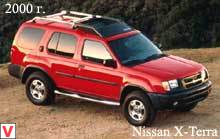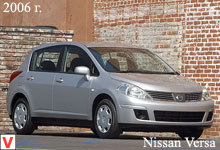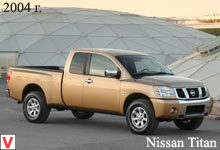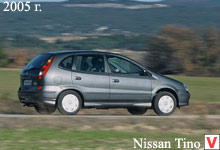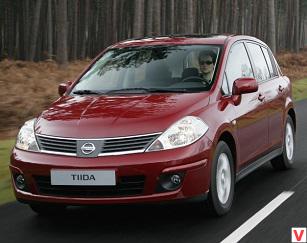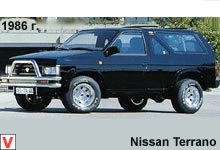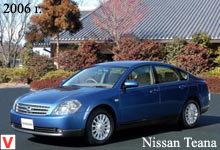
The Murano SUV was introduced to the general public in the fall of 2002. The novelty was named after the island of Murano, located near Venice and famous for its glassware. The car is built on the new platform Altima. It is distinguished not only by its excellent dynamic characteristics, but also has an unusual design. Murano impresses with its original appearance. A large base, short, rounded "nose" and "feed", strongly tilted windshield - and all this is planted on impressive 18-inch wheels. In short, a bright and harmonious blend of sports wagon and SUV, radiating strength, confidence and clearly attracting the attention of others.
Unlike other SUVs in the outlines of Murano, you will not find a single straight line, no sharp angle. The manufacturer was not mistaken, claiming that the car has the most modern and stylish design, thanks to which you will not confuse Murano with any of the competitors. Interior decoration is original, concise and very high quality. Manufacturers have abandoned wood trim, so plastic, leather and aluminum predominate.
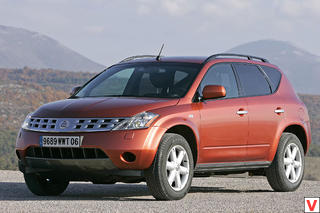
Deserves special attention arrangement driver's seat. The creators can adjust the seat, steering column (tilt) and pedal unit (front and back). Moreover, most adjustments are equipped with electric drives and memory for two combinations. The second-row passengers are truly at ease and comfortable when their two spaces allow them to throw their legs on the leg, and the backs are adjusted to the slope. Standard equipment includes such systems as climate control, a ventilation system, a stereo system with a 6-disc player, heated seats, electric windows and Bose audio control buttons on the steering wheel.
In short, the manufacturer has made every effort to ensure that the driver and passengers feel most comfortable. However, if the standard set is not enough for you, you can additionally order a leather interior, an electric sunroof, a GPS navigation system and a tunable pedal assembly. For the safety of the driver and passengers are responsible front and side airbags, curtains for the head, ventilated disc brakes on all 4 wheels and ABS. The choice of engines is limited to a single V6 (3.5 liters, 245 hp, 350 Nm), working in conjunction with a V-belt variator. The CVT is a continuously variable transmission. It is used to smoothly change the rotational speed of the driven shaft.
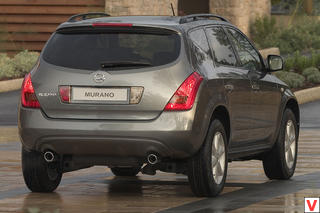
But the feature of the Nissan Murano is that the powerful 245 hp engine is combined with the variator, this is the first car with such power that was curbed by the variator. The power unit is located transversely and even in the all-wheel drive vehicle modification, the front wheels remain the main driving wheels - there is no center differential, and instead an electronically controlled clutch is installed that connects the rear wheels when the front wheels slip. Off-roading is intended for the second 4x4 mode: a rigid connection of the drive of both axes, which automatically returns to the first mode, just as the speed exceeds 30 km / h.
As for the high cross, then Murano does not pretend to it, although it is possible to note such off-road advantages as short overhangs, blocking the distribution of torque between the axles and lowering the register of the “automatic machine”. The ground clearance of only 178 mm - best speaks of the urban purpose of Murano. This is evidenced by the low located oil cooler of the transmission, covered with dirt only by a thin shield.
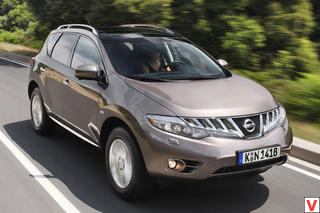
So, stylish appearance, rich equipment, spacious interior plus good acceleration dynamics, road handling and excellent work of the variator indicate that the Nissan Murano, a worthy fighter in his sport, is also one of the least expensive among competitors. The debut of the Russian version of the second-generation Nissan Murano crossover took place in February 2009. Wanting to keep and multiply the number of loyal fans of Murano, manufacturers did not begin to change the model drastically.
She just improved. The exterior has become even sportier and more muscular. The overall proportions of the crossover remained almost unchanged, but the front and rear parts have been significantly updated.
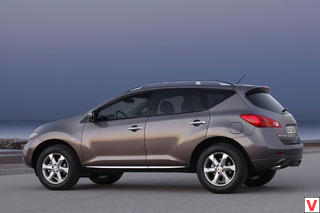
Headlights almost merged with the grille, and instead of vertical rear lights now horizontal. Due to these changes, Nissan Murano was able to lengthen by a few centimeters without increasing the wheelbase. In addition, the crossover slightly increased in growth. Salon is still spacious, space on both rows is more than enough. All materials used in the interior trim are expensive and of high quality, and the colors and textures are pleasant to the eyes and touch. In general, the design has become richer and more luxurious than the previous model.
Expensive leather upholstery in black or beige with double stitching, aluminum inserts, pleasantly modified center console and dashboard with control buttons on the ribs of cylindrical devices, soft variable backlighting fully comply with the ideas about the comfort of a business class car. Control of windows and mirrors moved to the very top of the door and is right at hand. True, they had to sacrifice the seat memory buttons, which shifted almost to the bottom of the door. Improved soundproofing cabin.
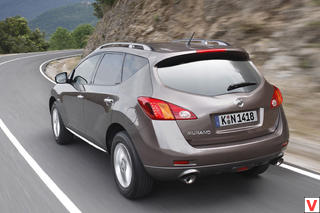
In the basic configuration, the Murano II is equipped with an Intelligent Key system for keyless access to the car with a button for starting the engine, remote control of the rear seats, a rear view camera with night mode, a premium audio system, Bluetooth hands-free and a satellite navigation system with 7-inch color touch screen. In more expensive configurations available electric tailgate, as well as a DVD-player with a overhead monitor for passengers in the rear row of seats. Known for the first generation Murano, the 3.5-liter engine was updated and added up to 249 hp. (265 hp in the American version).
The stepless variator Xtronic CVT (Continuously Variable Transmission) has been updated even more substantially. Changes in the pressure control system and the introduction of a new microprocessor, which controls the shift process of the Xtronic CVT, the stepless variator, significantly optimized the shift process, making it smoother and faster. The fact that a serious work has been done on a bunch of variable-speed motor can convince fuel consumption, which does not exceed 15 liters in a passport. The system of intelligent all-wheel drive All Mode 4x4-i with electromagnetic clutch provides the ability to transfer up to 50% of the torque to the rear wheels.
At the same time, at speeds up to 80 km / h, All Mode 4x4-i works proactively, allowing for the front wheels to slip in advance, based on the throttle position and torque, and transferring torque to the rear axle, without waiting for the wheels to lose road grip. At speeds above 80 km / h, the system works without anticipation, responding only to the actual wheel slip. The suspension began to work noticeably quieter and more comfortable.
The crossover copes with the roughness of the road better than its predecessor. Murano II was built on the same D-class platform as the Teana. Additional transverse ribs made it possible to increase the torsional rigidity of the platform immediately by 45%. In general, it is very bad impact on the handling and stability of the car.
But the soft suspension now allows for deeper roll in corners. The body of the new Murano has a special highly elastic polymer coating Scratch Shield, which restores the paintwork surface after light scratches: when a body covered with such paint heats up in the sun, minor scratches are tightened. The coating is applied to the seven available body colors. Nissan Murano II is much better than its first generation.

